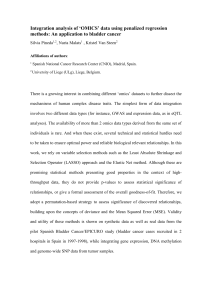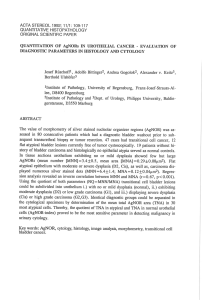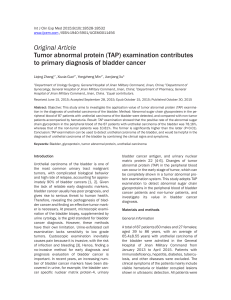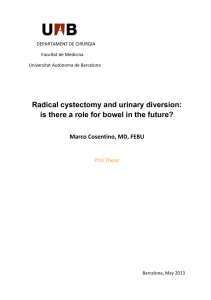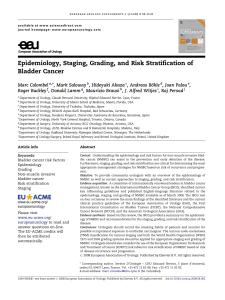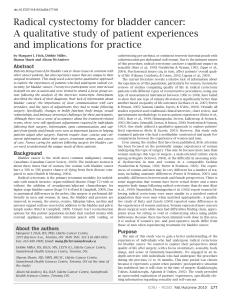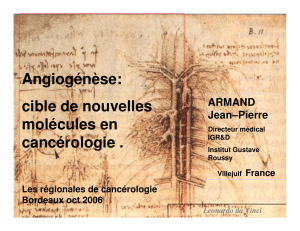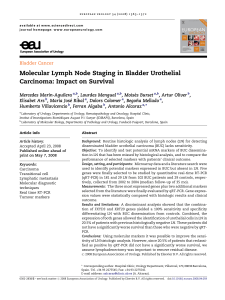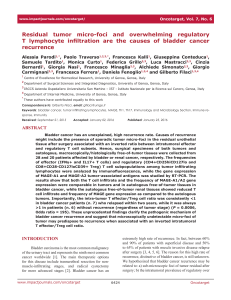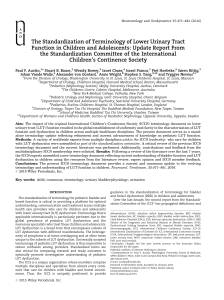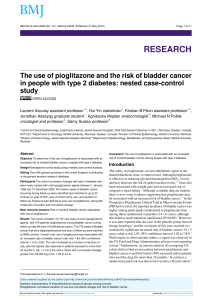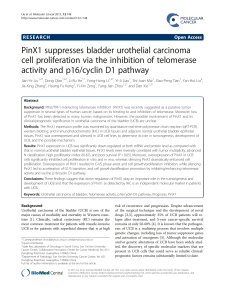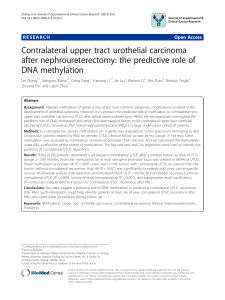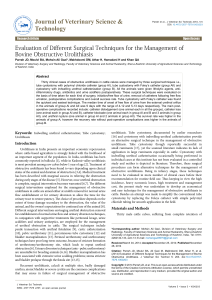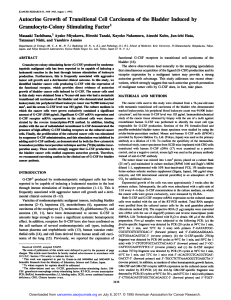Original Article BLCA1 expression is associated with angiogenesis of pro-angiogenic factors
publicité
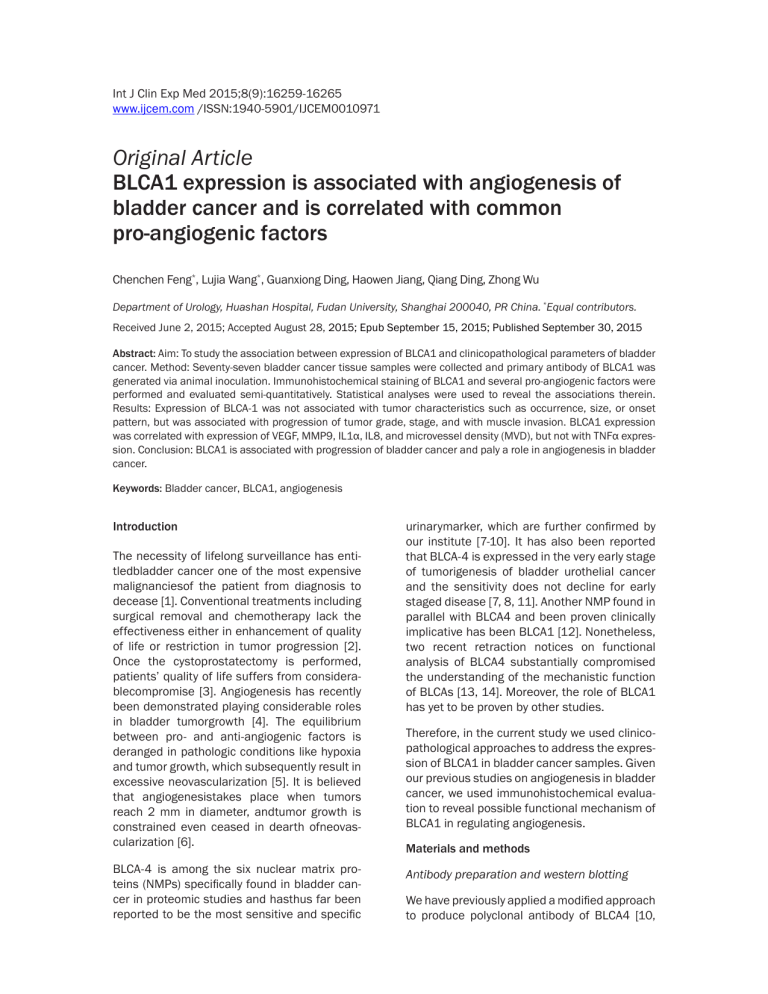
Int J Clin Exp Med 2015;8(9):16259-16265 www.ijcem.com /ISSN:1940-5901/IJCEM0010971 Original Article BLCA1 expression is associated with angiogenesis of bladder cancer and is correlated with common pro-angiogenic factors Chenchen Feng*, Lujia Wang*, Guanxiong Ding, Haowen Jiang, Qiang Ding, Zhong Wu Department of Urology, Huashan Hospital, Fudan University, Shanghai 200040, PR China. *Equal contributors. Received June 2, 2015; Accepted August 28, 2015; Epub September 15, 2015; Published September 30, 2015 Abstract: Aim: To study the association between expression of BLCA1 and clinicopathological parameters of bladder cancer. Method: Seventy-seven bladder cancer tissue samples were collected and primary antibody of BLCA1 was generated via animal inoculation. Immunohistochemical staining of BLCA1 and several pro-angiogenic factors were performed and evaluated semi-quantitatively. Statistical analyses were used to reveal the associations therein. Results: Expression of BLCA-1 was not associated with tumor characteristics such as occurrence, size, or onset pattern, but was associated with progression of tumor grade, stage, and with muscle invasion. BLCA1 expression was correlated with expression of VEGF, MMP9, IL1α, IL8, and microvessel density (MVD), but not with TNFα expression. Conclusion: BLCA1 is associated with progression of bladder cancer and paly a role in angiogenesis in bladder cancer. Keywords: Bladder cancer, BLCA1, angiogenesis Introduction The necessity of lifelong surveillance has entitledbladder cancer one of the most expensive malignanciesof the patient from diagnosis to decease [1]. Conventional treatments including surgical removal and chemotherapy lack the effectiveness either in enhancement of quality of life or restriction in tumor progression [2]. Once the cystoprostatectomy is performed, patients’ quality of life suffers from considerablecompromise [3]. Angiogenesis has recently been demonstrated playing considerable roles in bladder tumorgrowth [4]. The equilibrium between pro- and anti-angiogenic factors is deranged in pathologic conditions like hypoxia and tumor growth, which subsequently result in excessive neovascularization [5]. It is believed that angiogenesistakes place when tumors reach 2 mm in diameter, andtumor growth is constrained even ceased in dearth ofneovascularization [6]. BLCA-4 is among the six nuclear matrix proteins (NMPs) specifically found in bladder cancer in proteomic studies and hasthus far been reported to be the most sensitive and specific urinarymarker, which are further confirmed by our institute [7-10]. It has also been reported that BLCA-4 is expressed in the very early stage of tumorigenesis of bladder urothelial cancer and the sensitivity does not decline for early staged disease [7, 8, 11]. Another NMP found in parallel with BLCA4 and been proven clinically implicative has been BLCA1 [12]. Nonetheless, two recent retraction notices on functional analysis of BLCA4 substantially compromised the understanding of the mechanistic function of BLCAs [13, 14]. Moreover, the role of BLCA1 has yet to be proven by other studies. Therefore, in the current study we used clinicopathological approaches to address the expression of BLCA1 in bladder cancer samples. Given our previous studies on angiogenesis in bladder cancer, we used immunohistochemical evaluation to reveal possible functional mechanism of BLCA1 in regulating angiogenesis. Materials and methods Antibody preparation and western blotting We have previously applied a modified approach to produce polyclonal antibody of BLCA4 [10, BLCA1 and angiogenesis in bladder cancer Figure 1. Western blotting showingthe (A) specific band of BLCA1 in a dose-dependent manner; Immunopositive staining of (B) IL1α, (C) BLCA1, (D) VEGF, (E) IL8, (F) BLCA4, (G) MMP9, and (H) TNFα in bladder cancer. 15, 16]. A peptide sequenced as CEISQLNAGNH2 was synthesized and emulsified by intervals with Freund’s adjuvant (Sigma-Aldrich, MO, USA) and was subsequently immunized to 4 New Zealand white rabbits aged 3 to 9 months. After 4 times of immunization into the 3 to 4 s.c dorsal sites, the animals were bled from the auricular artery and the serum was collected. Binding pillars were used for serum purification and resulting antibody was therefore acquired. Standard western blotting procedure was carried out for specificity examination. Four samples were used to conduct the blotting: one from a high grade bladder urothelial cancer; one from pathologically confirmed normal bladder mucosa proximate to the bladder cancer in a cystectomy specimen; one from normal bladder tissue acquired via cup-biopsy; and one was phosphate buffered saline. The BLCA1 antibody was generated using the similar method [12]. The sequence used to generate the antibody was WLLEGFRSRR. Protein extractions together with PBS control were loaded 16260 with marker. Samples were then transferred to a polyvinylidenedifluoride membrane and were incubated overnight. All samples were rinsed with Tris-buffered saline (TBS) (Dako Corp., CA, USA), the membrane was treated with antiBLCA1/4 antiserum at 1:400 dilution with nonfat dry milk. Goat anti-rabbit IgG conjugated with horseradish peroxidase was then added at 1:1000 of dilution. Color development was finalized with enhanced chemiluminescence (ECL) (Amersham International, Buckingham, UK). Patients and samples Tissue samples from 77 patients with bladder urothelial cancer were included in this study amid which 52 samples were collected via transurethral resections and 27 through radical cystoprostatectomies, all performed at Department of Urology, Huashan Hospital, between 2007 and 2014. Patients were at the mean age of 67.25 ± 12.81 ranging from 21 to 87 years. Int J Clin Exp Med 2015;8(9):16259-16265 BLCA1 and angiogenesis in bladder cancer Ethical approval was obtained from local ethical committee (HIRB). All sections were re-evaluated with hematoxylin-eosin stain, graded and staged according to the WHO/ISUP (2004) and UICC- TNM (2002), respectively as reported in our previous studies [16-20]. Tumor samples of Ta were accordingly classified as non-invasive papillary and of T1 as tumor invading subepithelial connective tissue, T2 as tumor invading muscle layer and T3-4 as tumor invading perivesical tissue and the prostate, uterus, vagina, pelvic wall and abdominal wall. Tumors were graded as papillary urothelial neoplasm of low malignant potential (PUNLMP), low-grade (LG) and high-grade (HG) urothelial carcinomas. Expressions of BLCA1, BLCA4, VEGF, MMP9, IL1α, IL8, TNFα, and microvessel density (MVD) were investigated using immunohistochemistry (IHC), and regions were chosen where no necrotic tissue was observed and tumorous tissues were best identified. Immunohistochemistry All samples were formalin-fixed and subsequently paraffin-embedded. Slices were cut at 4 lm, and tissues were mounted on polylysinecoated glass slides. Endogenous peroxidase of deparaffinized sections was blocked through incubation with 3% hydro-gen peroxide for 15 min. Then, sections for PEDF staining were treated without boiling using TBS, pH 6.7 in microwave for 10 min. Sections for VEGF were boiled in 1 mM EDTA, pH 8.0 for 10 min and for MMP9, boiled in 1 mM citrate buffer, pH 6.0 for 10 min, each followed by cooling at room temperature for 20 min. Non-immunized horse serum was applied thereafter for 5 min in order to block non-specific antigen sites. Primary antibodies of BLCA1/4 were produced with the method aforementioned. Antibodies against VEGF (Thermo Scientific, CA, USA), MMP9 (Thermo), IL1α (Thermo), IL8 (Thermo), TNFα (Thermo), and vWF (von Willebrand Factor, Dako Corp., CA) were applied for 1 h each at a dilution of 1:100, 1:100 and 1:50, respectively. Following incubation, the sections were extensively rinsed and secondary antibodies were applied accordingly. A DAB (diaminobenzidinetetrahydrochloride) solution was then used for color developing. Finally, all slides were counterstained with Mayer’s hematoxylin blue in 0.3% ammonia. Positive control was ref. 16261 Sections applied with PBS (phosphate buffer solution) in lieu of primary antibody were studied as control. All samples were evaluated with a Nikon 80i microscope, and the extensity and intensity of staining were assessed semi-quantitatively and the evaluation criteria for BLCA4, VEGF, MMP9, IL1α, IL8, TNFα, and microvessel density (MVD) was reported by our group previously. The evaluation of BLCA1 was the same as that of BLCA4. Statistical methods An “SPSS 17.0 for Windows” program was performed for statistical analyses. All data were presented in the form of mean ± standard deviation (SD). The Mann-Whitney U-test was applied for comparing IHC scores between 2 cohorts. The Kruskal-Wallis test was wielded for comparisons of scores between 3 cohorts and more. Correlations between expressions of factors were evaluated with Spearman correlation test. A P value of < 0.05 was considered statistically significant. Results The expression of BLCA1 was confirmed by the specific band shown in western blotting in T24 bladder cancer cell line (Figure 1A). IHC showed nuclear staining of the BLCA1 (Figure 1B). Patient characteristics were summarized in Table 1. Expression of BLCA-1 was not significantly different between different genders (Table 1). Expression of BLCA1 was not associated with tumor characteristics such as occurrence, size, or onset pattern (Table 1). Gradual increase in BLCA1 expression level was noted with progression of tumor grade (Table 1). Of note, expression of BLCA1 was also increased with progression of tumor stage (Table 1). As muscle invasion characterized a unique special subtype of bladder cancer with distinct prognostic impact compared with non-muscle invasive entity, we further grouped tumors as nonmuscle invasive (NMIBC) versus MIBC. As expected, expression of BLCA1 was significantly higher in MIBC (Table 1). Expressions of other pro-angiogenic factors appeared in the pattern similar to our previous reports [16-20]. In general, higher expression of the factors was noticed in tumors with advanced grade and stage and was not associated with onset or occurrence (Table 1). The Int J Clin Exp Med 2015;8(9):16259-16265 BLCA1 and angiogenesis in bladder cancer Table 1. Expressions of BLCA1/4 and pro-angiogenic factors in relation with clinicopathological parameters (mean ± standard deviation) N BLCA1 BLCA4 VEGF MMP9 IL1α IL8 TNFα MVD Female 24 1.542 ± 1.1788 1.333 ± 1.1672 1.625 ± 1.1349 1.292 ± 0.9991 1.083 ± 0.9743 1.167 ± 0.8681 1.375 ± 0.9696 2.633 ± 1.2164 Male 53 1.472 ± 0.9115 1.66 ± 0.9394 1.509 ± 0.9328 1.434 ± 0.9905 1.679 ± 0.8497 1.566 ± 0.9305 1.679 ± 0.9359 2.794 ± 0.9357 0.81 0.222 0.718 0.495 0.006 0.102 0.167 0.649 Sex P Occurrence Single 48 1.375 ± 0.9368 1.417 ± 0.9857 1.417 ± 0.9639 1.292 ± 0.9666 1.417 ± 0.8464 1.438 ± 0.8227 1.5 ± 0.8752 2.59 ± 1.0028 Multiple 29 1.69 ± 1.0725 1.793 ± 1.0481 1.759 ± 1.0231 1.552 ± 1.0207 1.621 ± 1.0493 1.448 ± 1.0885 1.724 ± 1.0656 3 ± 1.0296 0.172 0.139 0.162 0.321 0.365 0.978 0.339 0.103 P Size < 3 cm 46 1.478 ± 0.9366 1.565 ± 1.0253 1.543 ± 0.9822 1.304 ± 0.9631 1.609 ± 0.954 1.413 ± 0.9793 1.739 ± 0.9294 2.835 ± 0.9682 ≥ 3 cm 31 1.516 ± 1.0915 1.548 ± 1.0276 1.548 ± 1.0276 1.516 ± 1.0286 1.323 ± 0.8713 1.484 ± 0.8513 1.355 ± 0.9504 2.61 ± 1.1086 0.935 0.893 1 0.414 0.153 0.631 0.086 0.387 P Onset Primary 57 1.579 ± 1.0342 1.632 ± 1.0459 1.649 ± 0.9909 1.368 ± 1.0112 1.526 ± 0.9278 1.491 ± 0.9087 1.579 ± 0.9991 2.844 ± 1.0932 Recurrent 20 1.25 ± 0.8507 1.35 ± 0.9333 1.25 ± 0.9665 1.45 ± 0.9445 1.4 ± 0.9403 1.3 ± 0.9787 1.6 ± 0.8208 2.46 ± 0.757 0.189 0.28 0.105 0.744 0.652 0.376 0.855 0.105 P Grade PUNLMP 12 0.333 ± 0.4924 0.25 ± 0.4523 0.5 ± 0.6742 0.75 ± 0.9653 1.167 ± 1.0299 0.75 ± 0.6216 1.5 ± 1.3143 1.175 ± 0.0866 LG 38 1.316 ± 0.7391 1.447 ± 0.7952 1.368 ± 0.7857 1.421 ± 0.8893 1.342 ± 0.8146 1.579 ± 0.8893 1.342 ± 0.7807 2.579 ± 0.6523 HG 27 2.259 ± 0.859 2.296 ± 0.8234 2.259 ± 0.859 1.63 ± 1.0432 1.852 ± 0.9488 1.556 ± 0.974 1.963 ± 0.8979 3.674 ± 0.6273 < 0.001 < 0.001 < 0.001 0.034 0.052 0.016 0.037 < 0.001 P Stage Ta 13 0.308 ± 0.4804 0.231 ± 0.4385 0.462 ± 0.6602 0.769 ± 0.9268 1.077 ± 1.0377 0.692 ± 0.6304 1.385 ± 1.3253 1.177 ± 0.0832 T1 26 1.154 ± 0.7317 1.231 ± 0.7646 1.154 ± 0.7317 1.346 ± 0.9356 1.269 ± 0.7776 1.615 ± 0.8979 1.269 ± 0.7243 2.231 ± 0.2739 T2 22 1.773 ± 0.6853 1.955 ± 0.653 1.818 ± 0.6645 1.636 ± 0.7895 1.773 ± 0.7516 1.5 ± 0.8591 1.773 ± 0.7516 3.364 ± 0.2665 T3-4 16 2.625 ± 0.6191 2.625 ± 0.6191 2.688 ± 0.6021 1.625 ± 1.2042 1.813 ± 1.1087 1.688 ± 1.0145 2 ± 1.0328 4 ± 0.5215 < 0.001 < 0.001 < 0.001 0.042 0.037 0.011 0.045 < 0.001 P Muscle invasion NMIBC 39 0.872 ± 0.7671 0.897 ± 0.8206 0.923 ± 0.7741 1.154 ± 0.9608 1.205 ± 0.8639 1.308 ± 0.9221 1.308 ± 0.9502 1.879 ± 0.5521 MIBC 38 2.132 ± 0.7771 2.237 ± 0.7141 2.184 ± 0.766 1.632 ± 0.9704 1.789 ± 0.9052 1.579 ± 0.9192 1.868 ± 0.8752 3.632 ± 0.5019 < 0.001 < 0.001 0.025 0.004 0.164 0.006 < 0.001 < 0.001 P LG = low Grade; HG = High grade. 16262 Int J Clin Exp Med 2015;8(9):16259-16265 BLCA1 and angiogenesis in bladder cancer Table 2. Correlations between expressions of BLCA1 and pro-angiogenic factors as well as microvessel density (MVD) in bladder cancer BLCA1 VEGF MMP9 IL1α IL8 TNFα MVD ** Correlation Co. Sig. (2-tailed) Correlation Co. Sig. (2-tailed) Correlation Co. Sig. (2-tailed) Correlation Co. Sig. (2-tailed) Correlation Co. Sig. (2-tailed) Correlation Co. Sig. (2-tailed) Correlation Co. Sig. (2-tailed) BLCA1 1.000 0.469** < 0.001 0.300** 0.008 0.255* 0.025 0.362** 0.001 0.204 0.076 0.664** <0.001 VEGF 0.469** < 0.001 1.000 0.172 0.134 0.262* 0.021 0.087 0.453 0.170 0.139 0.675** <0.001 MMP9 0.300** 0.008 0.172 0.134 1.000 0.022 0.848 0.100 0.387 0.297** 0.009 0.249* 0.029 IL1α 0.255* 0.025 0.262* 0.021 0.022 0.848 1.000 0.295** 0.009 0.285* 0.012 0.333** 0.003 IL8 0.362** 0.001 0.087 0.453 0.100 0.387 0.295** 0.009 1.000 0.036 0.753 0.312** 0.006 TNFα 0.204 0.076 0.170 0.139 0.297** 0.009 0.285* 0.012 0.036 0.753 1.000 0.242* 0.034 MVD 0.664** < 0.001 0.675** < 0.001 0.249* 0.029 0.333** 0.003 0.312** 0.006 0.242* 0.034 1.000 Correlation is significant at the 0.01 level (2-tailed). *Correlation is significant at the 0.05 level (2-tailed). MVD, which was a surrogate for angiogenesis was also increased with progression of tumor grade and stage (Table 1). As previous attempts on constructing the BLCA4 cDNA was compromised, we tried to address the function of BLCA1 using pathological evaluation. When we studied correlation between BLCA1 and pro-angiogenic factors, we found that BLCA1 expression was correlated with expression of VEGF, MMP9, IL1α, IL8, and MVD, but not with TNFα expression (Table 2). Correlations between VEGF, MMP9, IL1α, IL8, and TNFα were similar to our previous reports [16-20]. Discussion New growth in the vascular network is important since the proliferation, as well as metastatic spread, of cancer cells depends on an adequate supply of oxygen and nutrients and the removal of waste products [21]. The discovery of angiogenic inhibitors should help to reduce both morbidity and mortality from carcinomas. Thousands of patients have received antiangiogenic therapy to date. Despite their theoretical efficacy, anti-angiogenic treatments have not proved beneficial in terms of long-term survival. Identification of critical angiogenic factor could substantially improve treatment efficacy. More than a dozen different proteins have been identified as angiogenic activators, includ- 16263 ing vascular endothelial growth factor (VEGF), basic fibroblast growth factor (bFGF), angiogenin, transforming growth factor (TGF)-α, TGFβ, tumor necrosis factor (TNF)-α, plateletderived endothelial growth factor, granulocyte colony-stimulating factor, placental growth factor, interleukin-8, hepatocyte growth factor, and epidermal growth factor [22]. Up-regulation of the activity of angiogenic factors is in itself not enough to initiate blood vessel growth, and the functions of negative regulators or inhibitors of vessel growth may need to be down-regulated. There are many naturally occurring proteins that can inhibit angiogenesis, including angiostatin, endostatin, interferon, platelet factor 4, thorombospondin, prolactin 16 kd fragment, and tissue inhibitor of metalloproteinase-1, -2, and -3. Several studies have indicated that angiogenic activators play an important part in the growth and spread of tumors [22]. On immunohistochemical examination, the VEGF family and their receptors were found to be expressed in about half of the human cancers investigated [18-20]. These factors are known to affect the prognosis of adenocarcinomas that have developed in variety of cancers. Previous studies have identified 5 nuclear structural proteins (BLCA1 to 6) that are specifically expressedin bladder cancer tissue. The nuclear matrix is thesupport scaffold of the cell nucleus [12, 15]. This structure has various functions, of which many have implications in Int J Clin Exp Med 2015;8(9):16259-16265 BLCA1 and angiogenesis in bladder cancer cancer progression. The only research on BLCA1 thus far indicates that the antibody has successfully been produced against the bladder cancer specific biomarker BLCA1, which can be used in immunoblots selectively to detect BLCA-1 in the tissue and urine of patients with bladder cancer but not in tissue or urine samples from normal donors [12]. This study demonstrates that an antibody produced to the NMP BLCA-1 can selectively differentiate tissue and urine from individuals diagnosed with bladder cancer and normal donor patients. This protein is a urine based marker of bladder cancer that could be used in conjunction with the already developed BLCA-4 urine based ELISA assay or alone to enhance the sensitivity and specificity of the detection of this disease. Nonetheless, attempts on unveiling the cDNA of BLCA4 is proven problematic after so many years from its first report [13, 14]. The authors claim that the studies performed in the article used a cDNA sequence that at the time of publication the authors believed to encode BLCA-4. The authors feel that although this is still likely the case, there currently exists some uncertainty whether the cDNA sequence indeed encoded this protein. The authors believe that the work performed in the article is fully supported, but that the conclusions reached may differ based upon this potential. Therefore in the current study, we have applied the IHC method to investigate the potential role of BLCA1 and found the association between BLCA1 and angiogenesis in bladder cancer. Although the result remains to be validated, it offers insight to this clinically implicative protein. Acknowledgements The authors declare that no conflict of interest exists. This study was supported in part by the Science and Technology Commission Shanghai Municipality. (Grant No. 124119a2000). Disclosure of conflict of interest None. Address correspondence to: Dr. Zhong Wu, Department of Urology, Huashan Hospital, Fudan University, 12 Central Urumqi Rd, Shanghai 200040, PR China. Tel: +86-21-52887080; E-mail: drwuzhong@163. com 16264 References [1] Milojevic B, Dzamic Z, Kajmakovic B, Milenkovic Petronic D and Sipetic Grujicic S. Urothelial carcinoma: Recurrence and risk factors. J BUON 2015; 20: 391-398. [2] Jarvinen R, Marttila T, Kaasinen E, Rintala E, Aaltomaa S, Kallio J, Liukkonen T, Puolakka VM, Seppanen M, Tuhkanen K, Vaarala M, Viitanen J, Bostrom PJ; FinnBladder Group. Long-term Outcome of Patients with Frequently Recurrent Non-muscle-invasive Bladder Carcinoma Treated with One Perioperative Plus Four Weekly Instillations of Mitomycin C Followed by Monthly Bacillus Calmette-Guerin (BCG) or Alternating BCG and Interferonalpha2b Instillations: Prospective Randomised FinnBladder-4 Study. Eur Urol 2015; 68: 6117. [3] Al Hussein Al Awamlh B, Lee DJ, Nguyen DP, Green DA, Shariat SF and Scherr DS. Assessment of the quality-of-life and functional outcomes in patients undergoing cystectomy and urinary diversion for the management of radiation-induced refractory benign disease. Urology 2015; 85: 394-400. [4] Wang YW, Chuang JJ, Chang TY, Won SJ, Tsai HW, Lee CT, Cheng HL, Tzai TS, Liu HS and Chow NH. Antiangiogenesis as the novel mechanism for justicidin A in the anticancer effect on human bladder cancer. Anticancer Drugs 2015; 26: 428-436. [5] Meierjohann S. Hypoxia-independent drivers of melanoma angiogenesis. Front Oncol 2015; 5: 102. [6] Bhat TA and Singh RP. Tumor angiogenesis--a potential target in cancer chemoprevention. Food Chem Toxicol 2008; 46: 1334-1345. [7] Konety BR, Nguyen TS, Brenes G, Sholder A, Lewis N, Bastacky S, Potter DM and Getzenberg RH. Clinical usefulness of the novel marker BLCA-4 for the detection of bladder cancer. J Urol 2000; 164: 634-639. [8] Konety BR, Nguyen TS, Dhir R, Day RS, Becich MJ, Stadler WM and Getzenberg RH. Detection of bladder cancer using a novel nuclear matrix protein, BLCA-4. Clin Cancer Res 2000; 6: 2618-2625. [9] Getzenberg RH, Konety BR, Oeler TA, Quigley MM, Hakam A, Becich MJ and Bahnson RR. Bladder cancer-associated nuclear matrix proteins. Cancer Res 1996; 56: 1690-1694. [10] Feng CC, Wu Z, Jiang HW, Wen H, Guan M and Ding Q. Urinary BLCA-4 level is useful to detect upper urinary tract urothelial cell carcinoma. Actas Urol Esp 2012; 36: 597-602. [11] Zhao Q, Shen WH, Chen ZW, Zhou ZS and Ji HX. High expression level of BLCA-4 correlates Int J Clin Exp Med 2015;8(9):16259-16265 BLCA1 and angiogenesis in bladder cancer [12] [13] [14] [15] [16] [17] with poor prognosis in human bladder cancer. Int J Clin Exp Pathol 2012; 5: 422-427. Myers-Irvin JM, Landsittel D and Getzenberg RH. Use of the novel marker BLCA-1 for the detection of bladder cancer. J Urol 2005; 174: 64-68. Myers-Irvin JM and Getzenberg RH. Retraction: Mechanistic analysis of the role of BLCA-4 in bladder cancer pathobiology. Cancer Res 2014; 74: 974. Van Le TS, Myers J, Getzenberg RH, Konety BR and Barder T. Retraction: Functional characterization of the bladder cancer marker, BLCA-4. Clin Cancer Res 2013; 19: 3327. Feng C, Wang P, Guan M, Jiang H, Wen H, Ding Q and Wu Z. Urinary BLCA-4 is highly specific for detection of bladder cancer in Chinese Han population and is related to tumour invasiveness. Folia Biol (Praha) 2011; 57: 242-247. Feng C, Wu Z, Guo T, Jiang H, Guan M, Zhang Y, Wen H and Ding Q. BLCA-4 expression is related to MMP-9, VEGF, IL-1α and IL-8 in bladder cancer but not to PEDF, TNF-α or angiogenesis. Pathol Biol 2012; 60: e36-e40. Feng C, Guan M, Ding Q, Zhang Y, Jiang H, Wen H, Wang P and Wu Z. Expression of pigment epithelium-derived factor in bladder tumour is correlated with interleukin-8 yet not with interleukin-1α. J Huazhong Univ Sci Technolog Med Sci 2011; 31: 21-25. 16265 [18] Feng CC, Ding Q, Zhang YF, Jiang HW, Wen H, Wang PH and Wu Z. Pigment epithelium-derived factor expression is down-regulated in bladder tumors and correlates with vascular endothelial growth factor and matrix metalloproteinase-9. Int Urol Nephrol 2011; 43: 383390. [19] Feng CC, Guan M, Wang PH, Ding Q, Zhang YF, Jiang H, Wen H and Wu Z. Pigment epitheliumderived factor inhibits T24 bladder cancer cell growth in vitro and in vivo. Rom Biotechnol Lett 2011; 16. [20] Feng CC, Wang PH, Ding Q, Guan M, Zhang YF, Jiang HW, Wen H, Wu Z. Expression of pigment epithelium-derived factor and tumor necrosis factor-α is correlated in bladder tumor and is related to tumor angiogenesis. Urol Oncol 2013; 31: 241-246. [21] Gacche RN. Compensatory angiogenesis and tumor refractoriness. Oncogenesis 2015; 4: e153. [22] Gabunia K and Autieri MV. Interleukin-19 can enhance angiogenesis by Macrophage Polarization. Macrophage (Houst) 2015; 2: e562. Int J Clin Exp Med 2015;8(9):16259-16265
